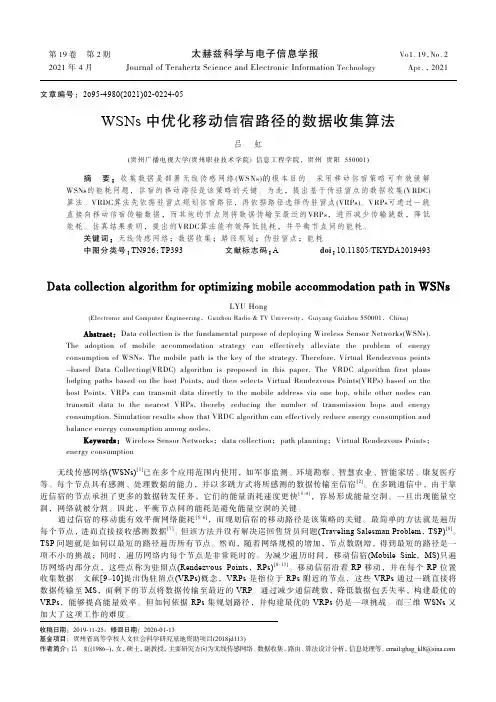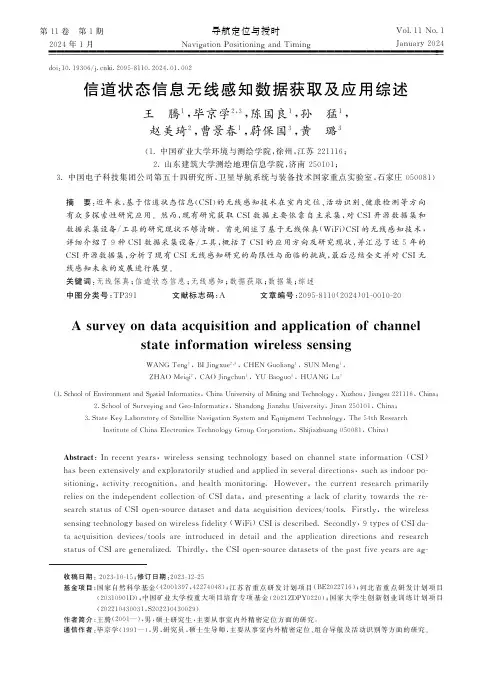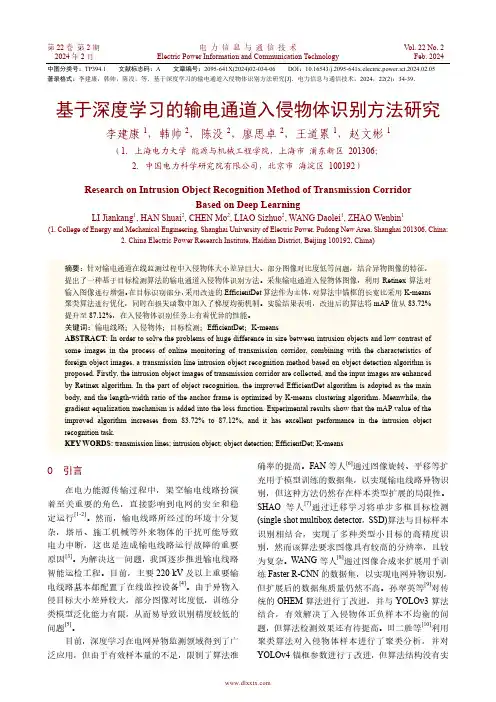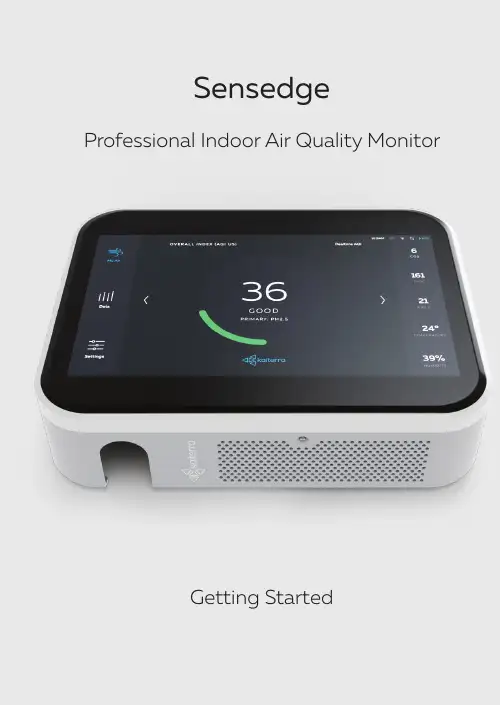Power-aware distributed protocol for a connectivity problem in wireless sensor networks
- 格式:pdf
- 大小:200.57 KB
- 文档页数:15


第19卷 第2期 太赫兹科学与电子信息学报Vo1.19,No.2 2021年4月 Journal of Terahertz Science and Electronic Information Technology Apr.,2021文章编号:2095-4980(2021)02-0224-05WSNs中优化移动信宿路径的数据收集算法吕 虹(贵州广播电视大学(贵州职业技术学院)信息工程学院,贵州贵阳 550001)摘要:收集数据是部署无线传感网络(WSNs)的根本目的。
采用移动信宿策略可有效缓解 WSNs的能耗问题,信宿的移动路径是该策略的关键。
为此,提出基于伪驻留点的数据收集(VRDC)算法。
VRDC算法先依据驻留点规划信宿路径,再依据路径选择伪驻留点(VRPs)。
VRPs可通过一跳直接向移动信宿传输数据,而其他的节点则将数据传输至最近的VRPs,进而减少传输跳数,降低能耗。
仿真结果表明,提出的VRDC算法能有效降低能耗,并平衡节点间的能耗。
关键词:无线传感网络;数据收集;路径规划;伪驻留点;能耗中图分类号:TN926;TP393 文献标志码:A doi:10.11805/TKYDA2019493Data collection algorithm for optimizing mobile accommodation path in WSNsLYU Hong(Electronic and Computer Engineering,Guizhou Radio & TV University,Guiyang Guizhou 550001,China)Abstract:Data collection is the fundamental purpose of deploying Wireless Sensor Networks(WSNs).The adoption of mobile accommodation strategy can effectively alleviate the problem of energyconsumption of WSNs. The mobile path is the key of the strategy. Therefore, Virtual Rendezvous points-based Data Collecting(VRDC) algorithm is proposed in this paper. The VRDC algorithm first planslodging paths based on the host Points, and then selects Virtual Rendezvous Points(VRPs) based on thehost Points. VRPs can transmit data directly to the mobile address via one hop, while other nodes cantransmit data to the nearest VRPs, thereby reducing the number of transmission hops and energyconsumption. Simulation results show that VRDC algorithm can effectively reduce energy consumption andbalance energy consumption among nodes.Keywords:Wireless Sensor Networks;data collection;path planning;Virtual Rendezvous Points;energy consumption无线传感网络(WSNs)[1]已在多个应用范围内使用,如军事监测、环境勘察、智慧农业、智能家居、康复医疗等。

优化算法在无线通信中的功率分配问题中的应用研究标题:优化算法在无线通信中功率分配问题的应用研究摘要:无线通信中的功率分配问题是优化算法在通信系统中的一个重要应用领域。
本文以无线通信系统中功率分配问题为研究对象,介绍了优化算法在该问题中的应用研究,并详细分析了常见的优化算法在功率分配问题中的具体应用场景和优势。
通过对已有研究成果的综述和分析,本文总结了优化算法在功率分配问题中的优势和不足,提出了未来研究的方向和挑战。
关键词:优化算法、无线通信、功率分配、应用研究1. 引言在无线通信系统中,功率分配是一项关键的技术,其目的是合理分配通信系统中各个终端设备的功率,以保证网络的正常工作、提高系统性能并降低功耗。
功率分配问题由于涉及优化策略和算法的选择,一直是无线通信领域中研究的热点之一。
随着无线通信技术的发展和网络规模的扩大,功率分配问题不断变得更加复杂,传统的优化算法已经无法很好地解决这一问题。
而新兴的优化算法如遗传算法、粒子群算法、人工神经网络等,具备了更高的效率和鲁棒性,可以有效解决功率分配问题。
2. 传统的功率分配问题研究2.1 功率分配问题的数学模型传统的功率分配问题研究通常基于数学模型,将整个通信系统抽象为一个问题,并通过优化算法来寻找最优解。
最常见的数学模型是基于约束条件的优化问题,包括最大化系统容量、最小化功耗、最小化传输时延等。
这些问题都可以通过数学建模来描述,并应用优化算法进行求解。
2.2 传统优化算法在功率分配问题中的应用2.2.1 贪心算法贪心算法是一种简单而直观的算法,其在功率分配问题中的应用较为广泛。
贪心算法通过每次选择局部最优解来逐步构建全局最优解,具有简单高效的特点。
但贪心算法的缺点是容易陷入局部最优解,无法保证全局最优解。
2.2.2 最优化算法最优化算法是一类基于数学和计算方法的优化方法,其中包含了很多的子算法,如线性规划、非线性规划、整数规划等。
这些算法通过优化目标函数和约束条件来求解功率分配问题。



无线传感网络中能量和距离改良的LEACH分簇算法邬厚民【摘要】LEACH算法作为经典分簇算法在无线传感器网络中有着广泛应用,但由于没有考虑簇头数量及监测区域等因素,使得网络消耗巨大,大大缩减了网络的生命周期.针对这一缺陷,在Warneke的最优覆盖定理的基础上,提出CDE-LEACH算法,通过在基站中预构建“数据表”存储最优覆盖理想簇头位置坐标,结合保证网络能量消耗最小这一目标来选取最优的簇头,改善LEACH算法随机选择簇头的弊端.在Matlab 7.0实验仿真平台下对提出的CDELEACH算法进行仿真,与LEACH算法结果对比发现,网络能量消耗大大减少,并且延长了网络生命周期.%LEACH algorithm as a classic clustering algorithm is widely used in wireless sensor networks. But for the number of cluster head, monitoring areas and other factors are not taken into consideration, the network greatly consumes, and its life is hugely reduced. To overcome these defects, the author proposed a kind of CDE-LEACH algorithm on the basis of the optimal covering theorem presented by Wameke. In the suggested algorithm, iv pre-built "data table" to storage optimal coverage location coordinates of the ideal cluster head in the base station and combined with the goal of guaranteeing minimum network energy consumption to select the optimal cluster head, and to overcome the drawbacks of the cluster head randomly selected by the LEACH algorithm. The simulations of CED -LEACH algorithm and LEACH algorithm were carried out on the experimental simulation platform, Matlab 7.0, and their results were compared. The results show thesuggested algorithm greatly reduced the network energy consumption, and extend the network life cycle.【期刊名称】《中国测试》【年(卷),期】2012(038)005【总页数】5页(P62-65,101)【关键词】最优覆盖;CDE-LEACH算法;分簇;能量;距离【作者】邬厚民【作者单位】广州科技贸易职业学院,广东广州511442【正文语种】中文【中图分类】O233;TN926;TP393;TM930.120 引言能耗问题一直是制约无线传感器网络发展的关键问题。


• Temperature • Power Failure • Physical Security• Server Operation• Water on the floor• Network ConnectivitySENSAPHONE®REMOTE MONITORING SOLUTIONSInfrastructure Monitoring SystemsThe IMS series of Sensapahone products allows you to watch over many of the potential threats in your com-puter room. They combine environmental monitoring, physical security, network monitoring and more into one easy to manage system. The IMS System is always storing history and trending information, and will notify the appropriate personnel when conditions exceed acceptable limits. There are two different IMS solutions, the IMS-4000 and the IMS-1000. Both systems have the following features ...Servers don’t operate properly unless they are in a proper environment. High temperatures increase the chance ofa system crash. Power failure, water on the floor, smoke and fire obviously cause even more issues. Sensors are available for the IMS System to monitor all of the critical environmental conditions that are important for smooth operation of your computer equipment.There is a growing concern for physical security in the data center. Malicious activity, and even accidental activ-ity make it necessary to watch over your computer room. Who was there after hours? Who opened the cabinet door just before the system crashed? The IMS System has the capability to supply this type of information. Se-curity sensors can be configured to track all access activity in and around your data center and generate instant alarm notifications. Any monitored condition can even trigger an image capture from a camera which can be immediately e-mailed to the appropriate personnel.The IMS System provides integrated monitoring of network connectivity and server operation. A ping request can be sent periodically and an alarm is generated when there is no response. Even more detailed monitoring can be performed with the Port Service Response function. The IMS System can send specific requests to servers for SMTP, POP, HTTP, FTP, or any other port service for a proper response. You will know immediately when a service fails on any of your servers. And unlike other monitoring systems, a failure on your e-mail server won’t prevent the alarm message from being delivered. The IMS-4000 comes standard with a phone line interface for alarm notification, so network problems and server failures can’t prevent the alarm message frombeing delivered.SENSAPHONE IMS Solutions • Power FailureWhen an alarm condition is detected, the notification process begins. Both the IMS-4000 and IMS-1000 systems can deliver alarm messages through the network as e-mails and SNMP traps. For additional convenience and redundancy, the IMS-4000 has a built in telephone interface and the IMS-1000 has an optional phone interface. V oice phone calls can be made with custom messages describing, in your own voice, where the problem occurred. Messages are sent continuously until someone responds.History and Trends:Full event-history and trending are provided with the Data Logging feature. User-selectable sampling lets you store critical temperature, humidity, or other environmental information about your infrastructure by the minute, hour or day.Use the data for graphing, database, or auditing purposes. Events are recorded for review: user access, alarm detection, dispatch, and alarm acknowledgement. The IMS systems provide you with everything you need for a reliable and consistent audit trail.Alarm NotificationInfrastructure Monitoring EnvironmentalThreats Physical Security Network Connectivity• Send SNMP traps• Text MessagingThe IMS-1000 system is the newest addition to the Sensaphone IMS series of products. It is a lower cost version of the IMS-4000 that still provides effective infrastructure monitoring and alarm notification for many installations. Up to eight external sensors can be connected to the IMS-1000 to monitor a variety of environmental conditions. TCP/IP port service monitoring is also provided for up to 16 network devices or port services. An alarm condition is generated whenever any environmental sensor goes out of range, or when any network port service stops responding. The IMS-1000 will then initiate its alarm notification process fol-lowing the programmed list of personnel to be notified. E-mails are sent describing the alarm condition. If network cameras are installed, the e-mails will even contain one or more attached images captured from the video camera. SNMP traps can also be sent to network management systems.An internal telephone modem is available as an option to the IMS-1000 product. This feature provides additional options for alarm delivery. Custom messages can be recorded and stored in the 1000, and voice phone calls can be made to announce alarm conditions. In addition to the convenience of the voice phone call, the phone modem also provides an alarm delivery path indepen-dent of the computer network. In the case of network failures, or e-mail servers going offline, the phone call may be the only path available to properly notify the appropriate personnel.The IMS-1000 is designed for high reliability with no moving parts. It is completely standalone with its own internal battery backup system. All programming and status information are available through its internal web server. In addition to the web server, the IMS-1000 is fully SNMP manageable. The IMS-1000 solution can effectively monitor the most critical conditions in your server room or data center.The Two IMS SolutionsIMS-1000 – The Single Room Solution For larger monitoring requirements with multiple locations, theIMS-4000 Enterprise Solution can expand and grow with yourneeds. The IMS-4000 Host performs all of the same monitoringfunctions as the IMS-1000, but with the ability to monitor multiplelocations within a facility, or even multiple locations across theglobe. The key to this distributed monitoring is the addition ofIMS-4000 Nodes. Each Node can also monitor up to 8 externalIMS sensors, but it reports back to a Host through the network.Up to 31 IMS Nodes can report back to a single IMS Host. TheIMS-4000 Console View software package is included with eachHost providing an enterprise view of up to 32 locations per Host.If you have more than 32 locations, no problem, multiple Hostnetworks can be managed within the same Console View softwarepackage. A multi-site/multi-user software license is included withthe purchase of the Host, so you don’t need to worry about addi-tional licensing costs. Multiple users will have an enterprise viewfrom any location.In addition to the enterprise level monitoring that the IMS-4000 system provides, it also includes an assortment of advanced fea-tures not found in the IMS-1000. All environmental and IP alarms can be scheduled so that they are only monitored for alarms during certain hours, or certain days of the week. The alarm notification is more powerful with the phone modem and custom voice mes-sages are standard feature on the 4000. It can also provide alarm messages to fax machines and pagers. More notification flexibil-ity comes with the addition of time scheduling for users, and even alarm grouping for different groups of users. The IMS-4000 will make sure that only the appropriate users will be notified for each alarm condition.Controlling outlets is another feature that the IMS-4000 products can perform. Using the optional PowerGate products, outlets can be switched on or off by the network of Hosts and Nodes. Outlets can be controlled either manually, or even automatically in response to specific alarm conditions. You can automatically reboot network equipment when it stops responding.Up to 128 network cameras can be integrated into the IMS-4000 system. Multiple images can be viewed from the Console View software, and snapshots can be sent attached to e-mails when alarms occur. The IMS-4000 solution provides comprehensive monitoring for your complete enterprise.IMS-4000 – The Expandable Enterprise SolutionProduct FeaturesSensaphone IMS-1000Sensaphone IMS-4000Enterprise Hardware Expansion No Yes Enterprise Software Console No Yes Power Failure Monitoring Yes Yes Built-In Battery Backup Yes Yes High Sound Level Alarm No YesExternal SensorsUp to 88 per Host/Node, 256 totalAutomatic Sensor Identifi cation and Setup Yes Yes Sensor SupervisionYes Yes Cat5 Wiring for Sensor Extensions YesYesIP Monitoring 16 Devices or Servers64 per Host/Node, 2048 totalAlarm Notifi cation User Profi les 1664E-mail Notifi cation Yes Yes Pager Notifi cationYes Yes Voice Phone Call Notifi cation Optional Yes Customizable Voice Messages Optional Yes Remote Listen-In Over Telephone No Yes SNMP TrapsYes Yes SNMP Manageable Yes Yes Built-In Web Server Yes YesCameras32 External 128 ExternalCamera InterfaceOne at a timeEnterprise Multi-ViewAlarm Triggered Image Capture Yes Yes Scheduling for Alarms and Notifi cation No Yes User Grouping For Alarm Types No Yes Outlet ControlNo Optional Built-In RAS ServerNo Yes Two-Way E-mail Command Responder No Yes Data Logging and Event LoggingYes Yes Software Pop-Up When Alarms OccurNoYesIMS Comparison ChartIMS-1000 is the perfect monitoring solution for small to medium single room applications. The IMS-4000 pro-vides additional expansion, the ability to monitor multiple locations and an assortment of features not found on the IMS-1000. Use the chart below to see the specific differences between the two Solutions.LIT-0111 © 5.2007 by SensaphoneIMS-1000 SeriesIMS-1001 - Infrastructure monitoring system for single room applications.IMS-1002 - Same as IMS-1001 but with phone modem and voice communications.IMS-4000 SeriesIMS-4001 - Host device for Enterprise level Infrastructure Monitoring.IMS-4002 - Node device for local or wide area expansion of an IMS-4000 system.IMS-4301 - PowerGate for switching 8 low current outlets automatically or manually. IMS-4302 - PowerGate2 for switching 8 high current outlets automatically or manually.IMS AccessoriesIMS ProductsTemperature IMS-4810Mounts on wall or any flat surface to measure temperature in the room.Temperature w/ Display IMS-4811Wall mount temperature sensor with the addition of a local temperature display.Mini Temperature IMS-4812Used to measure temperature in a small space, inside cabinets or even directly on the surface of a piece of equipment.Humidity IMS-4820Mounts on a wall to measure relative humidity in a room.Humidity w/ Display IMS-4821Wall mount humidity sensor with the addition of a local display.Water Detection IMS-4830Used to detect the presence of water on a floor. Includes 10 feet of water sensing rope which can be extended with additional 10 foot sections.Power Failure IMS-4840Additional power failure monitoring can be added with one or more of these sensors. Actual AC V oltage is measured and used for alarming.15A Current Sensor 100-250 V AC 50/60Hz, IEC320 C14 inlet/C13 outlet - IMS-4841Connects in series with your servers or other network equipment to monitor how much current is being used.20A Current Sensor, 100-250V AC 50/60Hz, IEC320 C20 inlet/C19 Outlet - IMS-4842Monitors up to 20 Amps of current. Dry Contact IMS-4850Allows any dry contact to be interfaced with any of the IMS systems.4-20mA Bridge IMS-4851Allows any 4-20mA analog transducer to be interfaced with any of the IMS systems.Magnetic Reed Switch IMS-4860Used to monitor a door to a room, or even a cabinet door for unauthorized activity.Motion Sensor IMS-4861Physical security motion detector to detect unauthorized access.Smoke Detector IMS-4862Detect smoke and/or fire independently from your primary fire alarm system.Axis 206 Network Camera IMS-4420Panasonic BL-C10A Network camera with pan and tilt IMS-4421Distributed By:SENSAPHONE901 Tryens Road Aston, P A 19014 (610) 558-2700Fax (610) 558-0222 Protected under US Patent 7,009,510。

2024年2月Electric Power Information and Communication Technology Feb. 2024 中图分类号:TP394.1文献标志码:A文章编号:2095-641X(2024)02-034-06DOI:10.16543/j.2095-641x.electric.power.ict.2024.02.05著录格式:李建康,韩帅,陈没,等.基于深度学习的输电通道入侵物体识别方法研究[J].电力信息与通信技术,2024,22(2):34-39.基于深度学习的输电通道入侵物体识别方法研究李建康1,韩帅2,陈没2,廖思卓2,王道累1,赵文彬1(1.上海电力大学能源与机械工程学院,上海市浦东新区201306;2.中国电力科学研究院有限公司,北京市海淀区100192)Research on Intrusion Object Recognition Method of Transmission CorridorBased on Deep LearningLI Jiankang1, HAN Shuai2, CHEN Mo2, LIAO Sizhuo2, WANG Daolei1, ZHAO Wenbin1(1. College of Energy and Mechanical Engineering, Shanghai University of Electric Power, Pudong New Area, Shanghai 201306, China;2. China Electric Power Research Institute, Haidian District, Beijing 100192, China)摘要:针对输电通道在线监测过程中入侵物体大小差异巨大、部分图像对比度低等问题,结合异物图像的特征,提出了一种基于目标检测算法的输电通道入侵物体识别方法。

Power-awaredistributedprotocolforaconnectivityprobleminwirelesssensornetworks
R.MontemanniandL.M.GambardellaIstitutoDalleMollediStudisull’Intelligenza(IDSIA)Galleria2,CH-6928Manno-Lugano,Switzerland{roberto,luca}@idsia.ch
Abstract.Weconsidertheproblemofassigningtransmissionpowerstothenodesofawirelessnetworkinsuchawaythatallthenodesareconnectedbybidirectionallinksandthetotalpowerconsumptionisminimized.Wepresentadistributedprotocol,obtainedbyextendingaconnectivityprotocolrecentlyappearedintheliterature.Thenewextendedprotocolisobtainedbyusinginalocal,distributedfashion,well-knowncentral-izedtechniquesforpowerminimization.Theresultisaself-organizationframeworkwhereasetofrules,implementedlocallyateachnode,guar-anteesglobalproperties,i.e.connectivityandpowerexpendituremini-mization.Preliminarycomputationalresultsarefinallypresented.Theyshowthatthenewextendedprotocolguaranteesasubstantialsavinginthetotaltransmissionpower.
1IntroductionWirelesssensornetworkshavereceivedsignificantattentioninrecentyearsduetotheirpotentialapplicationsinbattlefield,emergencydisastersrelief,andotherapplicationscenarios(see,forexample,Bloughetal.[2],ChuandNikolaidis[3],Kirousisetal.[6],Lloydetal.[8],RamanathanandRosales-Hain[13],Singhetal.[15],Wanetal.[16]andWieselthieretal.[17]).Unlikewirednetworksofcellularnetworks,nowiredbackboneinfrastructureisinstalledinwirelesssensornetworks.Acommunicationsessionisachievedeitherthroughsingle-hoptransmissioniftherecipientiswithinthetransmissionrangeofthesourcenode,orbyrelayingthroughintermediatenodesotherwise.Weconsiderwirelessnetworkswhereindividualnodesareequippedwithomnidirectionalantennae.Typicallythesenodesarealsoequippedwithlimitedcapacitybatteriesandhavearestrictedcommunicationradius.Topologycon-trolisoneofthemostfundamentalandcriticalissuesinmulti-hopwirelessnetworkswhichdirectlyaffectsthenetworkperformance.Inwirelessnetworks,topologycontrolessentiallyinvolveschoosingtherightsetoftransmitterpowertomaintainadequatenetworkconnectivity.Incorrectlydesignedtopologiescanleadtohigherend-to-enddelaysandreducedthroughputinerror-pronechan-nels.Inenergy-constrainednetworkswherereplacementorperiodicmaintenance2R.MontemanniandL.M.Gambardellaofnodebatteriesisnotfeasible,theissueisallthemorecriticalsinceitdirectlyimpactsthenetworklifetime.
Inaseminalpaperontopologycontrolusingtransmissionpowercontrolinwirelessnetworks,RamanathanandRosales-Hain[13]approachedtheproblemfromanoptimizationviewpointandshowedthatanetworktopologywhichmini-mizesthemaximumtransmitterpowerallocatedtoanynodecanbeconstructedinpolynomialtimeinacentralizedfashion,i.e.withtheassumptionthatthenetworkisfullyknowntothecentralizedoptimizer.Thisisacriticalcriterioninbattlefieldapplicationssinceusinghighertransmitterpowerincreasestheprobabilityofdetectionbyenemyradar.Inthispaper,weattempttosolvetheminimumpowertopologyprobleminwirelessnetworks.Minimizingthetotaltransmitpowerhastheeffectoflimitingthetotalinterferenceinthenetwork.
Foragivensetoftransmittersspatiallylocatedinthenetwork’sarea(nodes),theminimumpowertopology(MPT)problem,sometimesalsoreferredtoasthemin-powersymmetricconnectivityproblem,istoassigntransmissionpowerstothenodesofthenetworkinsuchawaythatallthenodesareconnectedbybidi-rectionallinksandthetotalpowerconsumptionoverthenetworkisminimized.Havingbidirectionallinkssimplifiesone-hoptransmissionprotocolsbyallowingacknowledgementmessagestobesentbackforeverypacket(seeAlthausetal.[1]).Itisassumedthatnopowerexpenditureisinvolvedinreception/processingactivities.
Unlikeinwirednetworks,whereatransmissionfromitomgenerallyreachesonlynodem,inwirelesssensornetworkswithomnidirectionalantennaeitispossibletoreachseveralnodeswithasingletransmission(thisistheso-calledwirelessmulti-castadvantage,seeWieselthieretal.[17]).IntheexampleofFigure1nodesjandkreceivethesignaloriginatedfromnodeianddirectedtonodembecausejandkareclosertoithanm,i.e.theyarewithinthetransmissionrangeofacommunicationfromitom.Thispropertyisusedtominimizethetotaltransmissionpowerrequiredtoconnectallthenodesofthenetwork.
Althausetal.[1],Daset.al[4]andMontemanniandGambardella[9],[10]proposedexactalgorithmsfortheproblem.WerefertheinterestedreadertoMontemannietal.[12]foranoverview,comprehensiveoftheoreticalandex-perimentalcomparison,ofthesemethods.Alloftheseapproachesarebasedonmixedintegerprogrammingmodels,andallofthemaredesignedtoberuninacentralizedfashion,onasinglecomputerwithfullknowledgeofthenetwork,i.e.alltheinformationaboutthenetworkareassumedtobeavailableatacentralprocessor(e.g.powerrequiredbyeachnodetoreacheveryothernodeofthenetwork).Turningintorealworld,itisveryunlikelythatallthisknowledgeisavailableatthecentralprocessor,andevenifthisistrue,therewouldbethepracticalproblemoftransmittingoptimaltransmissionpowerstothenodes.Forthesereasonsdistributedprotocols,i.e.protocolsthatrunateachnodeofthenetwork,withapartialknowledgeofthenetwork-namelythesetofneighborsofeachnode-havetobedeveloped.